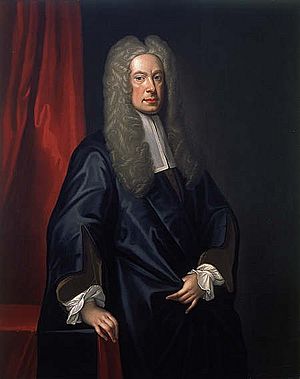Sir John Clerk, 2nd Baronet facts for kids
Quick facts for kids
John Clerk
|
|
|---|---|

John Clerk of Pennycuik, 2nd Baronet by William Aikman, (circa 1725)
|
|
| Member of Parliament for Scotland | |
| In office 1 May 1707 – 3 April 1708 Serving with numerous others
|
|
| Commissioner for Whithorn | |
| In office 1702–1707 |
|
| Personal details | |
| Born | 1676 |
| Died | 4 October 1755 (aged 79) Penicuik House, Midlothian |
| Political party | Whigs |
| Children | George Clerk Maxwell John Clerk of Eldin |
| Parents | Sir John Clerk, 1st Baronet Elizabeth Henderson |
| Alma mater | University of Glasgow Leiden University |
| Profession | Judge, Lawyer, Politician |
Sir John Clerk, 2nd Baronet (born around 1676 – died 4 October 1755) was an important person in Scottish history. He was a politician, a lawyer, a judge, and even a composer.
He was also the Vice-President of the Philosophical Society of Edinburgh. This was a very important group of smart people during a time called the Scottish Enlightenment. This period was when many new ideas in science, philosophy, and art became popular in Scotland.
Sir John Clerk was the father of George Clerk Maxwell and John Clerk of Eldin. He was also the great-great-grandfather of the famous scientist James Clerk Maxwell.
Contents
Early Life and Education
John Clerk was the son of Sir John Clerk, 1st Baronet. His mother was Elizabeth Henderson. A "Baronet" is a special title, like a knight, that can be passed down in a family.
He studied law at the University of Glasgow and then at Leiden University in the Netherlands. After his studies, he went on a "Grand Tour" in 1697 and 1698. This was a trip around Europe that young, wealthy men often took to learn about art, culture, and history.
In 1700, he became a lawyer in Scotland, which was called being "admitted to the Scottish Bar."
Planting Trees at Penicuik House
Between 1700 and 1730, Sir John Clerk planted many trees on his family's land at Penicuik House. He planted about 300,000 trees!
Sir John Clerk's Political Career
Sir John Clerk was a member of the Parliament of Scotland for an area called Whithorn. He served there from 1702 to 1707.
He was also chosen to be a Commissioner for the Union of Parliaments. This meant he helped decide if Scotland and England should join together to form Great Britain. He supported this idea as a member of the Whig Party.
Joining the British Parliament
Because of his support for the Union, he became a member of the first Parliament of Great Britain in 1707. This was a new parliament that represented both Scotland and England.
In 1708, he became a "Baron of the Exchequer" for Scotland. This was a judge in a special court that handled money matters for the government. He held this important job for almost 50 years.
His Thoughts on Daniel Defoe
Sir John Clerk wrote in his personal notes about Daniel Defoe. Defoe was an English writer and a secret agent. Clerk said that people didn't know at the time that Defoe had been sent by a powerful politician named Godolphin. Clerk wrote that Defoe was "a spy among us, but not known to be such." He believed that if people in Edinburgh had known, they "had pull him to pieces."
Sir John Clerk as a Scholar and Artist Supporter
Sir John Clerk was very interested in old things and history, which is called being an "antiquary." He wrote several papers for a scientific magazine called Philosophical Transactions.
- One paper, published in 1731, was about the writing tools and different types of paper used by ancient people.
- Other papers, published in 1739, were about how lightning affects trees and about finding large deer horns inside an oak tree.
He also wrote a book in Latin about Roman monuments, which was published in 1750. For over 20 years, he exchanged letters with another antiquary named Roger Gale.
Supporting Artists and Musicians
Sir John Clerk was a friend and supporter of the poet Allan Ramsay. Ramsay spent a lot of time at Penicuik House. Later, Sir John's son built a tall monument called an obelisk at Penicuik House to remember Ramsay.
Sir John also supported other artists and architects. He even tried his hand at architecture himself. He also loved music. When he was in Rome, he might have learned from a famous composer named Arcangelo Corelli. Sir John even wrote some songs, including a funny one called O merry may the maid be that marries the miller.
Sir John Clerk's Family Life
Sir John became the 2nd Baronet and took over his family's estates in 1722 after his father passed away.
He first married Lady Margaret Stewart in 1701. Sadly, she died in childbirth later that year. Their son, John, survived but died young in 1722 without marrying.
Sir John married again to Janet Inglis. They had a large family with seven sons and six daughters. He passed away at Penicuik House on 4 October 1755.

